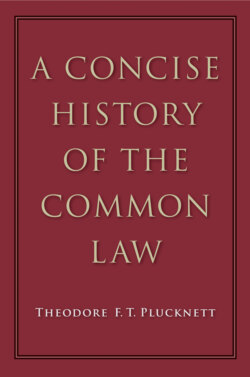Читать книгу A Concise History of the Common Law - Theodore F. T. Plucknett - Страница 110
На сайте Литреса книга снята с продажи.
6. The jury as a new mode of trial EVOLUTION OF THE PETTY JURY
ОглавлениеVarious devices which they tried have been traced with some success through the rolls. Even before the crisis of 1219 occasional cases are to be found of the presentment juries giving what has been called a “medial judgment”, that is to say, declaring what ordeal ought to be assigned. Again, a jury might be summoned to declare whether an appeal was brought “maliciously out of hate and spite” (de odio et atia). This issue was very frequently introduced by appellees who had purchased this concession from the Crown, and in fact came to be really conclusive as to the main question. It was, moreover, a first step in the direction of a criminal trial by jury, for after some years of hesitation it was realised that if a jury could by its verdict declare that an appeal was brought maliciously, there was no valid reason why it should not answer the straight question whether the prisoner was guilty or innocent.1 We soon find that this last step was taken. It must be remembered that all these proceedings took place in the course of eyres in the early years of the thirteenth century, when that institution was in its most vigorous period. On such an occasion the King’s justices had before them a very considerable number of jurors making presentments from vills and hundreds, from boroughs and the county itself. A presentment would be made by the representatives of one of these vills or hundreds,2 and in order to get a final verdict on the guilt or innocence of the prisoner the justices hit upon the device of associating with the presenting jury the juries of the four neighbouring vills; “afforced” in this way, the larger body then proceeded to answer the question whether the prisoner was guilty of the crime for which he had been indicted.
At first the judges exercised a good deal of discretion in making up the trial jury;3 at times they did not even trouble to add any further jurors at all, but merely inquired of the presenting jury whether the prisoner was guilty. At other times we find a very large body of jurors associated together as a trial jury—in one case we even find a jury of eighty-four persons. It seems, however, that in the early stages such a large body of jurors did not sit together, but was examined unit by unit, the verdict of the representatives from each of the different communities being taken separately. From the numerous verdicts so obtained (sometimes contradictory4 and sometimes expressed in terms of hesitation) the court formed its own conclusion and proceeded to judgment accordingly. Nor can we always say that these composite juries are giving verdicts in the modern sense of the word, for at times they merely provide the court with material upon which the court itself bases its finding of guilty or not guilty.
